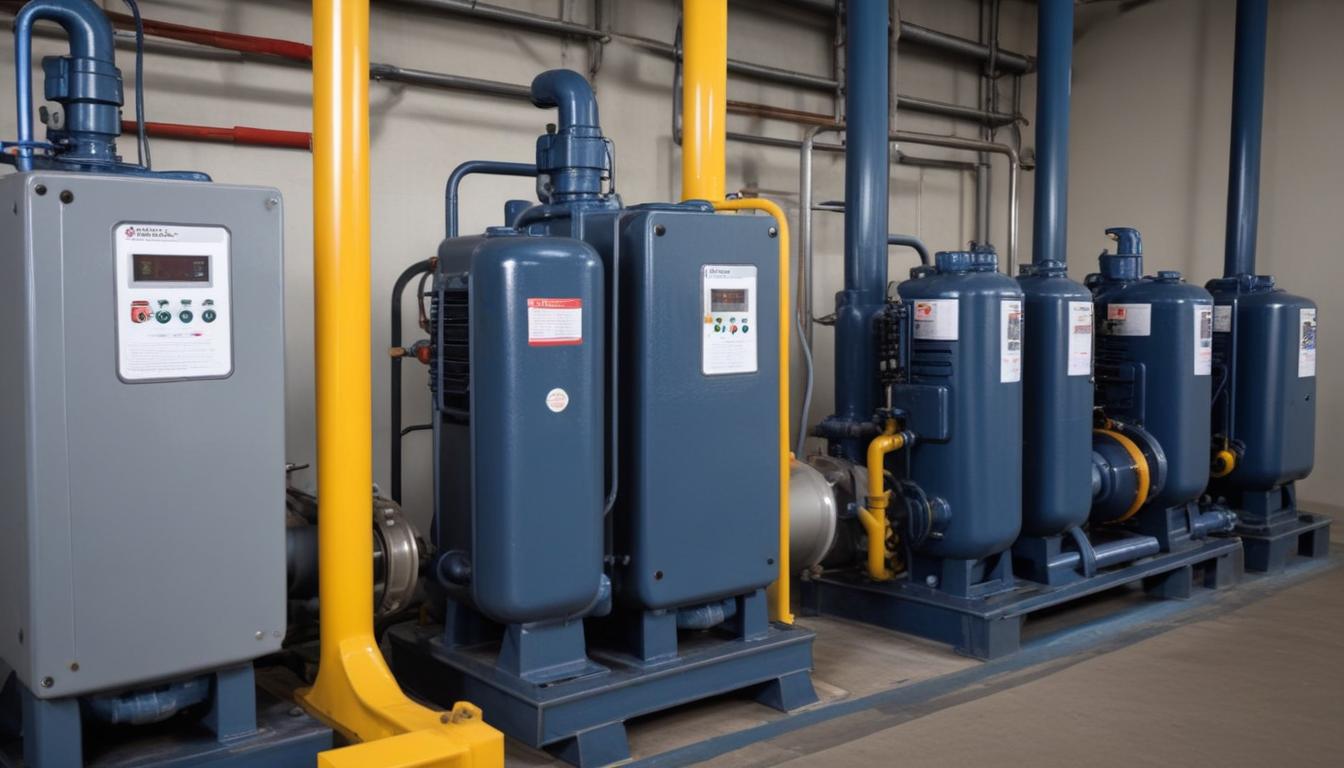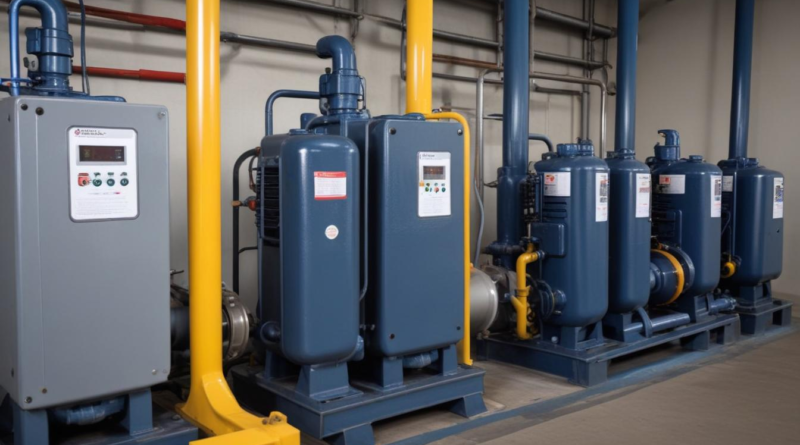how to choose a pump based on control options
Selecting the appropriate control options is pivotal in ensuring optimal pump performance and efficiency. These options determine how a pump responds to varying system demands and operational conditions. Understanding the different types of controls available can significantly influence the overall effectiveness of your pump system.
There are several key control options to consider:
- On/Off Control: The simplest form of control, where the pump operates at full capacity when activated and stops completely when not needed.
- Variable Frequency Drives (VFDs): Adjust the pump speed to match the required flow or pressure, offering enhanced energy efficiency and precise control.
- Pressure Control: Maintains a set pressure level within the system by adjusting the pump operation based on real-time pressure readings.
- Flow Control: Regulates the flow rate to meet specific process requirements, ensuring consistent performance despite fluctuations in demand.
- Temperature Control: Adjusts pump operation based on temperature changes to protect the system and maintain desired conditions.
When evaluating control options, it is essential to consider the following criteria to ensure the right fit for your application:
| Criterion | Description |
|---|---|
| System Demand | Assess the variability and range of flow or pressure required by the system. |
| Energy Efficiency | Evaluate how each control option impacts overall energy consumption and operational costs. |
| Precision | Determine the level of control accuracy needed for maintaining process stability. |
| Installation and Maintenance | Consider the complexity of installation and ongoing maintenance requirements for each control type. |
| Budget | Analyze the initial investment and long-term cost implications associated with each control option. |
By carefully evaluating these control options against your specific application needs and the outlined criteria, you can make informed decisions that enhance the reliability and efficiency of your pump system. This thorough understanding is critical in the broader context of pump selection, ensuring that the chosen control method aligns seamlessly with your operational objectives.
assessing pump types
When it comes to selecting a pump, understanding the variety of available types is crucial to ensure compatibility with your desired control methods and overall system performance. Each pump type has unique characteristics that make it more or less suitable for specific applications and control options. Below is an overview of the most common pump types and their key features:
- Centrifugal Pumps: These pumps are widely used due to their simplicity and efficiency in handling large volumes of liquid with relatively low viscosity. They operate by converting rotational energy from a motor into kinetic energy in the fluid, which is then transformed into pressure.
- Positive Displacement Pumps: These pumps move fluid by trapping a fixed amount and forcing it through the system. They are ideal for applications requiring precise flow control and the ability to handle high pressures and viscosities. Common types include gear, lobe, and diaphragm pumps.
- Submersible Pumps: Designed to operate while submerged in the fluid they are pumping, these pumps are typically used in applications such as wastewater management, drainage, and deep well pumping.
- Peristaltic Pumps: Utilizing a rotary mechanism to compress and release a flexible tube, these pumps provide gentle handling of sensitive fluids and are often used in medical and laboratory settings.
- Screw Pumps: These are a type of positive displacement pump that uses one or more screws to move fluids along the pump. They are particularly effective for handling viscous liquids and those containing solids.
To better illustrate how different pump types align with various control options, the following table provides a comparative overview:
| Pump Type | Suitable Control Options | Key Advantages | Common Applications |
|---|---|---|---|
| Centrifugal Pumps | On/Off Control, Variable Frequency Drives (VFDs), Pressure Control | High flow rates, energy-efficient with VFDs, simple design | Water supply, HVAC systems, irrigation |
| Positive Displacement Pumps | On/Off Control, Flow Control, Variable Frequency Drives (VFDs) | Precise flow control, handles high viscosity, consistent pressure | Chemical processing, food and beverage, pharmaceuticals |
| Submersible Pumps | On/Off Control, Timer-based Control | Compact, noise-reducing, suitable for deep applications | Wastewater management, sump pumping, dewatering |
| Peristaltic Pumps | Flow Control, On/Off Control | Gentle handling of fluids, easy maintenance, contamination-free | Medical devices, laboratory equipment, dairy processing |
| Screw Pumps | On/Off Control, Variable Frequency Drives (VFDs) | Handles viscous fluids, continuous operation, minimal pulsation | Oil and gas, lubricants, food processing |
When assessing pump types, it is essential to consider how each aligns with your specific control options and overall system requirements. Factors such as the desired flow rate, pressure, fluid characteristics, and operational environment play significant roles in determining the most suitable pump type. Additionally, evaluating the ease of integration with control systems and the potential for future scalability should be part of your criteria in the pump selection process. By methodically analyzing these aspects, you can ensure that the chosen pump not only meets current demands but also accommodates any anticipated changes in your application.
evaluating system requirements
Accurately evaluating system requirements is essential to ensure that the selected pump operates efficiently and reliably within your specific application. This process involves a comprehensive analysis of various factors that influence pump performance and compatibility with your existing system. Below are the key aspects to consider:
- Flow Rate: Determine the required flow rate, both average and peak, to ensure the pump can handle the desired volume of fluid without compromising performance.
- Pressure Requirements: Assess the necessary pressure levels, including any pressure surges or drops, to maintain system stability and meet operational demands.
- Fluid Characteristics: Examine the properties of the fluid being pumped, such as viscosity, temperature, corrosiveness, and the presence of solids or particulates, as these factors directly impact pump selection and material compatibility.
- Operating Environment: Consider the environmental conditions where the pump will be installed, including temperature extremes, humidity, exposure to hazardous substances, and space constraints.
- System Layout: Analyze the physical layout of the piping system, including the distance the fluid must travel, the number of bends and fittings, and the elevation changes, as these can affect pump performance and energy consumption.
- Power Supply: Verify the availability and specifications of the power supply, ensuring it matches the pump’s requirements for voltage, frequency, and phase.
- Regulatory and Safety Standards: Ensure compliance with relevant industry regulations and safety standards, which may dictate specific pump types or control mechanisms.
- Maintenance and Accessibility: Evaluate the ease of access for maintenance and the availability of spare parts, which can influence long-term operational efficiency and downtime.
To systematically organize and assess these factors, the following table outlines the primary system requirements and their implications for pump selection:
| System Requirement | Considerations | Impact on Pump Selection |
|---|---|---|
| Flow Rate | Average and peak flow demands | Select a pump that can meet or exceed the maximum required flow to ensure consistent performance. |
| Pressure | Operating pressure, pressure variations | Choose a pump capable of maintaining required pressure levels, possibly incorporating pressure control options. |
| Fluid Characteristics | Viscosity, temperature, corrosiveness, solids content | Opt for pump materials and types that are compatible with the fluid properties to prevent corrosion and wear. |
| Operating Environment | Temperature ranges, exposure to elements, space limitations | Select a pump design suited for the environment, such as submersible pumps for submerged applications. |
| System Layout | Pipe length, bends, elevation changes | Consider the pump’s ability to handle head loss and maintain flow stability across the system layout. |
| Power Supply | Voltage, frequency, phase requirements | Ensure the pump’s electrical specifications align with available power sources to avoid compatibility issues. |
| Regulatory Standards | Industry-specific regulations, safety codes | Choose pumps that comply with necessary standards to ensure legal and safe operation. |
| Maintenance | Accessibility, maintenance frequency, spare parts availability | Select pumps that are easy to maintain and supported by readily available parts to minimize downtime. |
Furthermore, understanding the control options in relation to your system requirements is crucial for optimal pump performance. For instance, a system with fluctuating flow demands may benefit from Variable Frequency Drives (VFDs) to adjust pump speed dynamically, enhancing energy efficiency and reducing wear. In contrast, applications requiring strict pressure maintenance might rely on pressure control mechanisms to ensure consistent operation.
When assessing system requirements, it is also important to consider future scalability and potential changes in operational demands. Selecting a pump and control system that can accommodate growth or modifications can save time and resources in the long run. Additionally, integrating smart control systems with monitoring and automation capabilities can provide real-time insights and improve overall system management.
In summary, a thorough evaluation of system requirements involves not only identifying the current operational needs but also anticipating future demands and ensuring that the chosen pump and control options are flexible and robust enough to adapt accordingly. By aligning these requirements with your criteria for pump selection, you can achieve a reliable and efficient pumping system tailored to your specific application.
considering energy efficiency
 Energy efficiency is a critical factor in pump selection, directly influencing both operational costs and environmental impact. Optimizing energy use not only reduces expenses but also aligns with sustainable practices and regulatory requirements. When evaluating energy efficiency, it is essential to consider how different control options and pump characteristics contribute to overall energy consumption. The following aspects are pivotal in assessing and enhancing the energy efficiency of your pumping system:
Energy efficiency is a critical factor in pump selection, directly influencing both operational costs and environmental impact. Optimizing energy use not only reduces expenses but also aligns with sustainable practices and regulatory requirements. When evaluating energy efficiency, it is essential to consider how different control options and pump characteristics contribute to overall energy consumption. The following aspects are pivotal in assessing and enhancing the energy efficiency of your pumping system:
- Variable Frequency Drives (VFDs): VFDs adjust the pump speed to match the actual demand, minimizing energy waste during periods of low flow or pressure requirements.
- High-Efficiency Pump Designs: Selecting pumps with optimized impeller designs and reduced hydraulic losses can significantly improve energy performance.
- System Hydraulics Optimization: Ensuring the piping system is designed to minimize friction losses and avoid unnecessary bends or restrictions can enhance pump efficiency.
- Regular Maintenance: Keeping pumps and motors well-maintained ensures they operate at peak efficiency, preventing energy losses due to wear or malfunction.
- Energy Monitoring and Management: Implementing advanced monitoring systems allows for real-time tracking of energy usage, enabling proactive adjustments and improvements.
To systematically evaluate the energy efficiency of different control options and pump selections, the following table outlines key factors and their implications:
| Factor | Description | Impact on Energy Efficiency |
|---|---|---|
| Control Option | The method used to regulate pump operation based on system demands. | Advanced control options like VFDs can significantly reduce energy consumption compared to basic On/Off controls. |
| Pump Type | The specific design and technology of the pump being used. | High-efficiency pump designs lower energy usage by reducing mechanical and hydraulic losses. |
| System Design | The overall layout and configuration of the pumping system. | Optimized system hydraulics decrease the workload on the pump, enhancing energy efficiency. |
| Operational Practices | How the pump system is used and maintained over time. | Regular maintenance ensures pumps run efficiently, preventing energy losses from degraded performance. |
| Energy Monitoring | The tools and processes used to track and manage energy usage. | Effective monitoring enables timely adjustments, maintaining optimal energy efficiency. |
Implementing energy-efficient practices involves a combination of selecting the right pump and control options, designing the system to minimize energy losses, and maintaining equipment to ensure ongoing efficiency. For example, integrating a Variable Frequency Drive (VFD) with a centrifugal pump allows the system to adjust flow rates dynamically, reducing energy consumption during periods of lower demand. Additionally, choosing pumps with energy-efficient motors and impellers tailored to the specific application can further enhance performance.
Moreover, optimizing the system hydrodynamics by reducing pipe lengths, minimizing bends, and avoiding unnecessary restrictions can lower the required pump head, thereby decreasing energy usage. Incorporating energy recovery systems, such as regenerative drives, can also capture and reuse energy within the system, contributing to overall efficiency gains.
Energy efficiency should be a key criterion in the pump selection process. By prioritizing energy-efficient options, organizations can achieve significant cost savings, reduce their carbon footprint, and comply with environmental regulations. Evaluating the total cost of ownership, which includes energy costs over the pump’s lifespan, provides a more comprehensive understanding of the long-term benefits associated with different pump and control options.
In conclusion, considering energy efficiency during pump selection involves a holistic approach that integrates advanced control options, efficient pump designs, optimized system layout, and proactive maintenance practices. By systematically addressing these elements, you can ensure that your pumping system operates sustainably and cost-effectively.
selecting the right controller
Selecting the appropriate controller is critical to achieving precise and reliable operation of your pumping system. The controller acts as the brain of the pump, managing its performance based on various input signals and predefined parameters. To ensure optimal pump performance and integration with your overall system, consider the following key aspects when choosing a controller:
- Control Strategy: Determine whether the application requires simple on/off control, proportional control, or more sophisticated algorithms such as PID (Proportional-Integral-Derivative) control. The complexity of your process will dictate the type of control strategy needed to maintain desired operating conditions.
- Compatibility: Ensure that the controller is compatible with the selected pump type and other system components. Compatibility involves matching electrical specifications, communication protocols, and physical interfaces to facilitate seamless integration.
- Scalability: Consider the potential for future system expansion or modifications. A scalable controller can accommodate additional sensors, actuators, or control loops without requiring a complete system redesign.
- User Interface: Evaluate the ease of use and accessibility of the controller’s interface. A user-friendly interface with clear displays, intuitive controls, and remote access capabilities can significantly enhance operational efficiency and troubleshooting.
- Communication Capabilities: Modern controllers often feature advanced communication options such as Ethernet, Modbus, or wireless connectivity. These capabilities enable integration with supervisory control and data acquisition (SCADA) systems, facilitating real-time monitoring and data analysis.
- Reliability and Durability: Select a controller known for its reliability and ability to operate under the environmental conditions specific to your application. Consider factors such as temperature ranges, humidity, vibration, and exposure to contaminants.
- Cost: Balance the initial investment with the long-term benefits. While advanced controllers may have a higher upfront cost, they can offer improved efficiency, reduced maintenance, and enhanced functionality that justify the expenditure over time.
To assist in the decision-making process, the following table provides a comparative overview of common controller types, their features, and suitable applications:
| Controller Type | Features | Advantages | Common Applications |
|---|---|---|---|
| On/Off Controllers | Simple switching based on setpoints, minimal configuration | Cost-effective, easy to install and maintain | Basic applications with limited control requirements, such as sump pumps and simple water systems |
| PID Controllers | Proportional, Integral, and Derivative control for precise regulation | High accuracy, stable control, suitable for dynamic systems | Industrial processes, HVAC systems, chemical dosing |
| Variable Frequency Drive (VFD) Controllers | Integrated motor speed control, energy monitoring | Enhanced energy efficiency, smooth operation, reduced mechanical stress | Applications requiring variable flow or pressure, such as HVAC, water treatment, and manufacturing |
| Smart Controllers | Advanced networking, data logging, remote access | Improved diagnostics, predictive maintenance, integration with IoT | Modern industrial systems, smart buildings, automated facilities |
| Programmable Logic Controllers (PLCs) | Customizable programming, multiple I/O handling | Highly flexible, capable of managing complex control sequences | Large-scale industrial automation, process control, manufacturing lines |
When selecting a controller, it is essential to define the criteria that align with your specific application requirements. Key criteria include:
- Control Precision: Assess the level of precision required for your application. High-precision processes may necessitate advanced controllers like PID or smart controllers.
- System Complexity: Evaluate the complexity of your pumping system. More intricate systems with multiple variables may benefit from programmable or PLC-based controllers.
- Budget Constraints: Balance the need for advanced features with budget limitations. Ensure that the selected controller provides the necessary functionality without exceeding financial constraints.
- Future Expansion: Consider the potential for system growth. A scalable controller can accommodate additional functionalities and integrations as your system evolves.
- Ease of Maintenance: Choose controllers that are easy to troubleshoot and maintain. Features like self-diagnostics and remote access can simplify maintenance tasks.
Integrating the right controller into your pump system enhances not only operational efficiency but also extends the lifespan of the pump by ensuring it operates within optimal parameters. For example, utilizing a Variable Frequency Drive (VFD) allows the pump to adjust its speed in response to real-time demand, thereby reducing energy consumption and minimizing wear and tear. Additionally, smart controllers with predictive maintenance capabilities can alert operators to potential issues before they lead to system failures, thereby reducing downtime and maintenance costs.
In conclusion, selecting the right controller involves a careful assessment of your control needs, system compatibility, and long-term operational goals. By aligning the controller’s features with your control options and criteria, you can achieve a highly efficient and reliable pump system tailored to your specific application.




